President Franklin D. Roosevelt, the nation’s first real seagoing chief executive, made port at Edgartown Sunday afternoon in the midst of the nor’west squall, and lay there at anchor until the following morning when he got under way for Nantucket. The visit was entirely impromptu weather conditions making it highly practical that he seek shelter, and the president did not himself land, although invitations to remain overnight ashore were extended to him. But his son James landed and made the acquaintance of the town, exchanging friendly remarks with various persons he met.
Watchful eyes were directed seaward during the entire day, and the approach of the Amberjack II was observed as soon as she made West Chop on her run out of Woods Hole. Charles Ellis, assistant lightkeeper at the chop, stood by the reservation flagstaff, it being Keeper James Yate’s day off, and dipped the colors as the president’s yacht and escorting destroyers sped past, receiving a return salute from the destroyers’ sirens in return. This was the president’s first Island greeting. Shores and headlands were quickly dotted with people who sped to these points of vantage to watch the progress of the yacht past the Island and it was a sight that drew more than one complimentary remark from the older men who still continue to take a man’s measure by his ability in seamanship.
Under Darkening Skies
Dark, lowering clouds rolled across the heavens, with a light spot here and there to relieve the gloom. The water was dark and flecked with foam. Against this dark background sped the little schooner, a single reef in her mainsail, foresail and forestaysail spread and hard-filled, leaning to the fresh norwester that breezed on her starboard quarter. Her fisherman’s bow hung slightly lifted, for the sea was smooth, and a broad streak of her copper showed amidst the foam that flung from her forefoot.
“Logging a good nine Knots,” observed an oldtimer; “the old man’s carting canvas.”
And then the first squall struck with increasing wind that whistled along the bluffs, bringing a torrent of rain and thickening the mist that hung over the water. It was no surprise to the seawise watchers when the Amerberjack hauled on the wind and headed for Edgartown. Any one of them would have done that same, and respect for the navigator’s sagacity heightened as they observed the move.
At Edgartown the lower streets and wharves were thickly sprinkled with spectators, coming and going. Newspaper representatives scurried to and fro. Boats sped from shore through the rain, and others from the destroyers, circled in ceaseless patrol about the anchored yacht, while telephone and telegraph wires burned hot between the Vineyard and the mainland, as the nation was notified that the president had come to anchor in Edgartown harbor. And amidst it all, the president was on deck, clad in his dripping oilskins, looking over the schooner’s gear and rigging, exactly as any fishing skipper would have done, the oldtimers breathed a word of admiration. For everything was snug on deck, sails properly stopped, sheets and halliards coiled down, and all things shipshape, before the president went below.
But the disappearance of the president from the scene had no effect upon the crowd. No president has visited the Vineyard since Grover Cleveland, and the bare fact that President Roosevelt was aboard the schooner to bring many of the Islanders to the harborfront, where they walked or stood in the pelting rain, hoping that he might again reappear.
No one among Island officials visited the president’s yacht. Apparently all were of the same mind regarding this matter, for those who were questioned on the subject flatly refused to consider it.
Entitled to a Needed Rest
“The man is trying to rest,” said one, “and the Lord knows he needs it.
Morning papers were obtained from the mainland by Charles S. Norton of Vineyard Haven, who had them sent down by plane. Arriving after the Amberjack had sailed, the plane followed, delivering the papers at Nantucket.
Paul Rust, owner of the Amberjack, and James Roosevelt visited the Edgartown Drug Store to make telephone calls. Mr. Rust tried to reach Charlie Welch and sent his regards to him.
Invitations were sent to the president to avail himself of comfort ashore, but he preferred to stick to his vacation idea of roughing it aboard the yacht. Mrs. William B. Dinsmore extended an invitation, as did I. Richmond Hoxie, who has known the president over a period of years.
Although many Islanders from all towns visited the Edgartown wharves, none stayed long and at no time was there a vast throng, as intimated by mainland newspaper despatches. A few boats went within respectful distance of the Amberjack, but no one attempted to be nosey, and the Vineyard population afloat and ashore was disposed to respect the president’s vacation privacy.
The two destroyers, the Ellis and the Bernadou, lay at anchor in the outer harbor. The Cuyahoga, a seagoing Coast Guard cutter, painted white, lay inside the lighthouse and attracted a great deal of attention. The seventy foot motor cruiser Comanche, carrying most of the newspaper correspondents, anchored not far from the Amberjack and at a greater distance was the Mary Alice, forty-five foot auxiliary ketch, also used by the newspaper men. The presidential fleet also included a ninety-foot auxiliary schooner, the Indra, chartered to carry the official press photographers, but she had run on the sand in Marion harbor and did not show up.
The president got under was on schedule Monday morning, leaving Edgartown between 6 and 6:30. There were no crowds to see him off, but plenty of Islanders were normally astir at that hour and watched the Amberjack and the rest of the fleet depart.
At Nantucket the president was met by a delegation of town officials. He did not, however, go ashore. He told the Nantucketers that he did not expect to set foot ashore for two weeks.

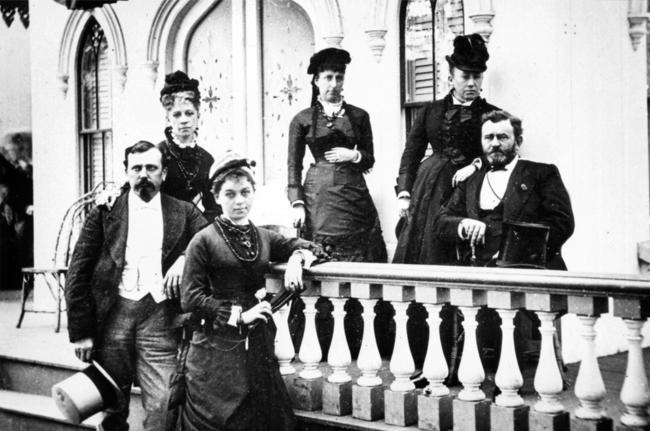




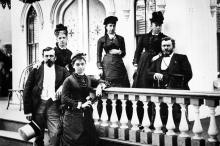
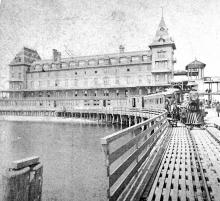
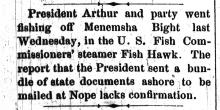
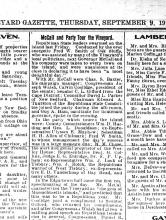
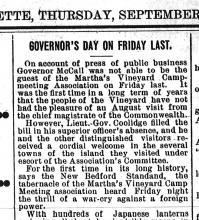
Comments